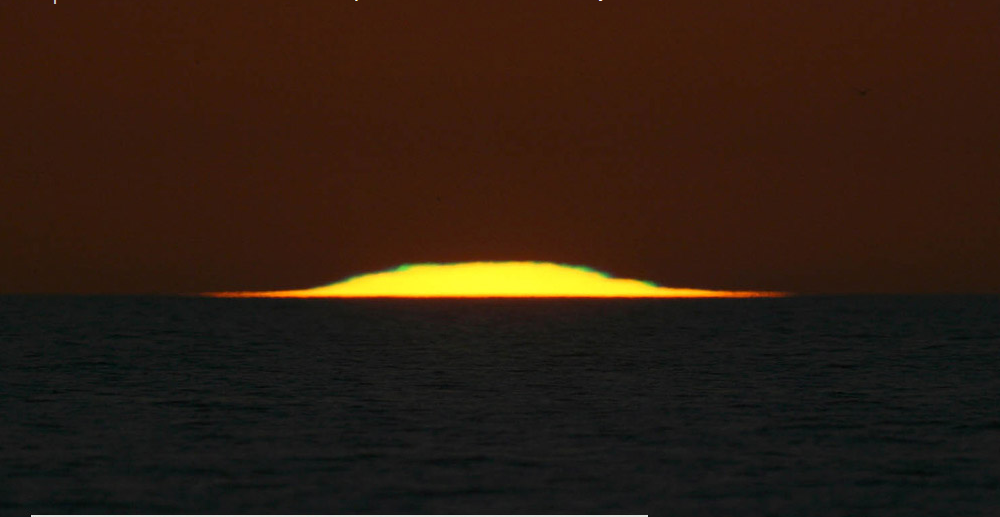OPOD - Tin Hat Mirage
OPOD - Tin Hat Mirage: Exploring the Phenomenon of Green Flashes and Distorted Sunsets
Have you ever witnessed a breathtaking sunset that seemed to defy the laws of nature? Perhaps you caught a glimpse of a green flash or a highly distorted sunset that left you in awe. In this article, we delve into the fascinating atmospheric optics phenomenon known as the "Tin Hat Mirage," which showcases these mesmerizing occurrences.
Renowned photographer Rick Albrecht, based in Florida, has captured numerous unique sunsets using his specialized equipment. Using a 1100mm F/7 lens/scope extended to 2200mm, he has managed to document the elusive and distorted Florida sunsets, particularly of the inferior mirage type. These mirages occur when warm air lies beneath cooler air, leading to intriguing optical effects.
One of Rick's captures stood out from the rest. As the sun descended, green flashes became visible at the top. However, what made this particular sunset distinct was the presence of a thin line of sun right on the horizon that lasted for approximately 14 seconds after becoming flat. As the sequence progressed, the remaining disk of the sun gradually flattened until only a bright line remained, which eventually broke into fragments before disappearing altogether.
This unique sequence has been dubbed a "tin-hat" mirage by early researchers, drawing inspiration from the tin hats worn by the American WWI Expeditionary Force. To understand this phenomenon, we need to explore the concept of temperature inversions. These inversions occur when cooler air exists beneath warmer air, creating an abnormal temperature gradient.
During a tin-hat mirage, sun rays are refracted downwards towards the ocean due to the temperature gradient between the two air layers. This refraction produces an inverted slice of the sun beneath the usual image. As rays pass deeper into the inversion layer, they generate a third erect image closest to the horizon. The bending of rays toward the ocean can result in long-distance travel along the curvature of the Earth, known as "ducting."
When temperature inversion gradients are sufficiently strong, ducting can occur, leading to highly flattened sunset mirages. In the case of the Florida mirage, it is possible that a very thin duct close to the ocean surface produced the observed phenomenon. The resulting line represents an extremely flattened image of the entire solar disk, creating a truly remarkable sight.
It is worth noting that Californian sunset mirages differ from the Florida mirage. In California, a cool offshore ocean current combined with warm air predominantly gives rise to mock-mirages, which differ from the distinct characteristics of the tin-hat mirage.
The study of atmospheric optics continues to captivate researchers and enthusiasts alike. Through the lens of photographers like Rick Albrecht, we gain insights into the complexities and wonders of our atmosphere. As we unravel the mysteries behind phenomena like the tin-hat mirage, we deepen our understanding of the natural world and its intricate workings.
Next time you witness a sunset, keep your eyes peeled for any hints of green flashes or distorted images. Who knows what atmospheric secrets may be unveiled before your very eyes?

Tin Hat Mirage
Green flashes and a highly distorted sunset imaged by Rick Albrecht from Florida.
©Rick Albrecht, shown with permission.

Rick uses a 1100mm F/7 lens/scope extended to 2200mm to capture unusual sunsets from Blind Pass between Sanibel and Captiva Islands, Florida.
Mostly his distorted Florida.. sunsets are of the inferior mirage type .warm air beneath cooler. leading to a classical green flash - "..the bottom edge of the sun on the horizon closes in and becomes narrow, in many cases it narrows so much it leaves a segment of the sun floating briefly a little above the apparent horizon. If the air is clear enough this segment will turn green and produce a Green Flash."
This one was quite different - "There was a thin line of sun right on the horizon that lasted for about 14 seconds after the line became flat."
As the sun descended green flashes were visible on the top. The remaining disk became more and more flattened until eventually only a bright line remained that then broke into fragments before disappearing.
The sequence has been by called a 'tin-hat' mirage by an early researcher after those worn the American WWI Expeditionary Force.
A temperature inversion, abnormally cooler air beneath warmer, is necessary to produce the mirage. Sun rays are refracted downwards towards the ocean by the temperature gradient between the two air layers. The rays produce an inverted slice of the sun beneath the ‘normal’ image. Rays passing deeper into the inversion layer produce a third erect image closest to the horizon.
If the temperature inversion gradients are strong enough the ray bent toward the ocean can travel for long distances around the curvature of the Earth. This ‘ducting’ often produces highly flattened sunset mirages. It is possible that the Florida mirage was produced by a very thin duct close to the ocean surface. In that case the line is an extremely flattened image of the whole solar disk.
.. In contrast to Californian sunset mirages where a cool offshore ocean current combined with warm air mostly gives mock-mirages.
Note: this article has been automatically converted from the old site and may not appear as intended. You can find the original article here.
Reference Atmospheric Optics
If you use any of the definitions, information, or data presented on Atmospheric Optics, please copy the link or reference below to properly credit us as the reference source. Thank you!
-
<a href="https://atoptics.co.uk/blog/opod-tin-hat-mirage/">OPOD - Tin Hat Mirage</a>
-
"OPOD - Tin Hat Mirage". Atmospheric Optics. Accessed on April 24, 2024. https://atoptics.co.uk/blog/opod-tin-hat-mirage/.
-
"OPOD - Tin Hat Mirage". Atmospheric Optics, https://atoptics.co.uk/blog/opod-tin-hat-mirage/. Accessed 24 April, 2024
-
OPOD - Tin Hat Mirage. Atmospheric Optics. Retrieved from https://atoptics.co.uk/blog/opod-tin-hat-mirage/.